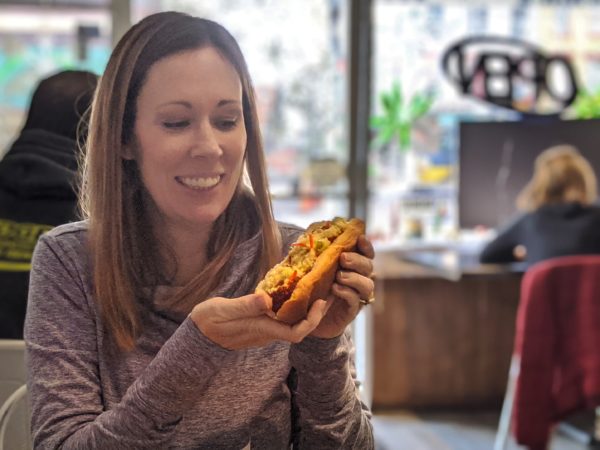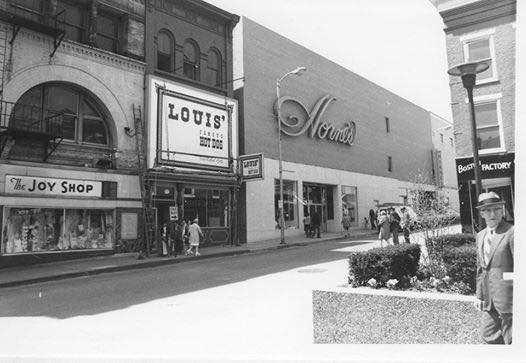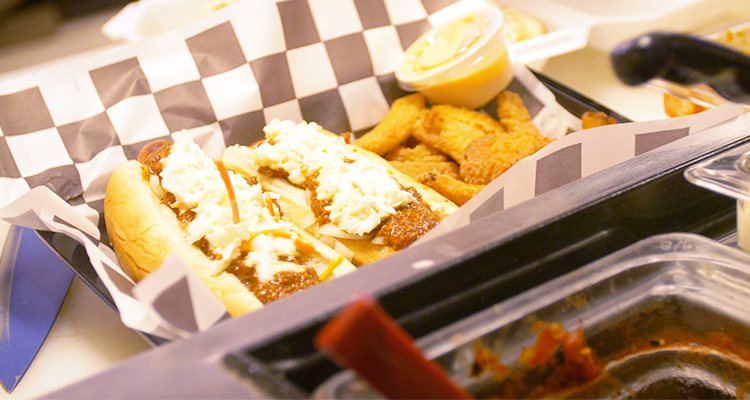I just ate my first West Virginia Hot Dog yesterday down at Tito’s Sloppy Doggs. In the past, my relationship with the hot dog was wishy-washy. A good hot dog is an amazing thing, but a bad one is enough to turn you off for years.
I admit I haven’t paid much attention to the West Virginia Hot Dog. I just knew it was out there, like the pepperoni roll, claiming our state as its birthplace, and that nobody beyond our borders recognized it as a proprietary wonder.
Just as non-West Virginians have no idea what a pepperoni roll is, they also fail to understand why anyone would pile chili, onions, mustard and coleslaw on a hot dog. Until recently, I didn’t get it either. I was a hot dog minimalist. As of Wednesday, at 12:48 p.m., I’m a convert, and I intend to spend the rest of my life championing the miracle that is the West Virginia Hot Dog.
Or, maybe, something a little less grandiose. Either way, what’s the deal with this West Virginia delicacy?

THE ORIGIN STORY
While it’s unclear where the West Virginia Hot Dog was born, the West Virginia Hot Dog Blog reports that it may have originated in Charleston during the Great Depression. Like the pepperoni roll, the hot dog fit the needs of anyone with a short, standing lunch break, a need for protein to sustain their body through manual labor (like digging for coal) and limited funds. Multiple, inexpensive toppings created a more filling meal that accommodated a limited budget.
The hot dog worked well, financially, for both the seller and the buyer. They were cheap to assemble, and the glut of toppings meant the dog itself didn’t have to be the finest cut of meat ever laid out in a bun. Per the West Virginia Hot Dog Blog, while cities like Chicago and New York City pride themselves on fine hot dog meat, the real essence of the West Virginia Hot Dog lies in the dance between chili sauce and slaw. The tangy/spicy combo can taste wildly different, depending on the heat level of the sauce or the slaw ingredients. Every hot dog joint will have their own recipe, but one thing is clear: the toppings are the stars.
A WORD ABOUT TOPPINGS
Again, the West Virginia Hot Dog is topped with sauce, onions, mustard and coleslaw. “Sauce” in West Virginia Hot Dog speak technically means chili con carne; that is, chili without beans. In Huntington, it’s just referred to as “sauce.” It’s thinner than traditional chili; this is not a chili dog. It’s a dog with chili-like sauce. Got it?
The West Virginia Hot Dog may be the ancestor of the “slaw dog,” a popular southern iteration that appeared in places where West Virginians settled after leaving the state to find work. What’s more, though slaw on a West Virginia Hot Dog is gospel, don’t ask for it in Marion County. According to The Hot Dog Blog author Stanton Means, Marion County is the “center of the anti-slaw resistance.” Slaw is more common in the southern parts of West Virginia and a little less so as you go north, likely due to the Italian population’s focus on the chili. Marion County has notable Italian heritage.
It should also be noted that the National Hot Dog and Sausage Council has some rules of etiquette when it comes to hot dogs. Those of you who apply ketchup should, apparently, be ashamed of yourselves, as “no one over 18 should ever eat ketchup on a hot dog. Ketchup is destructive of all that is right and just about a properly assembled hot dog since its sweetness and acidic taste overpowers food and disguises its true flavor.”
Likewise, “sun-dried tomato buns or basil buns are considered gauche with franks.”
LOCAL HOT DOG JOINTS
In 1992, the Charleston Daily Mail’s Becky Fleming wrote a piece called “State Divided by Invisible Slaw Line,” for which she spoke with Pete Mamakos, of Louis’ Famous Hot Dogs. Her article revealed that Marion County isn’t the only place where West Virginians eschew coleslaw on their dogs.
“Travel north through West Virginia, and you cross a line invisible to the eye but vital to the stomach,” she wrote. “South of that line you can walk into any local grill and get a hot dog or barbecue nicely sweetened with a spoonful of coleslaw. North of that line — the Slaw Line, we’ll call it — they look at you in wonder when you place your order.
As for coleslaw on a hot dog, Mamakos told her, it’s a no-go. “Nobody up here likes it, maybe one in 1,000. Chili, onions and mustard — that’s ‘everything’ to us,’ he said.”
Louis’ Famous Hot Dog was the most notable hot dog joint in Wheeling until recently. Founded in 1919, the restaurant operated downtown for many years. For the restaurant’s 50th anniversary in 1969, the paper advertised, “Louis Mamakos grilled an all-meat hot dog, tucked it in a fresh bun with tangy mustard, his delicious meat sauce and chopped onions.” In celebration, you could buy a 30-cent hot dog and get a second for 15 cents. Despite the deal, this was a big jump from the 1943 price of seven cents. In 1981, a new location opened in the Elm Terrace Shopping Center; the downtown location closed after 80 years in 1999. Longtime customers included WVU Head football coach Bill Stewart.

Though Louis’ Hot Dogs closed in 2013, you can get a traditional West Virginia Hot Dog at Tito’s, as I did, and this one comes with slaw. Owner Christopher Burress, who named the business after his father, decided to add the West Virginia Hot Dog to the menu when a customer came in one day and suggested it. The West Virginia dog sells well, he said.
I honestly thought it would be bigger, an unwieldy monster of a mess in my hand, like trying to eat a burrito that falls apart the minute you pick it up. Quite the opposite. The West Virginia Hot Dog and its topping stayed neatly in the bun, and I found that the ingredients aren’t individually discernible. Rather, as intended, they do come together to complement each other and … oh heck, people. It’s not a wine label — it’s a delicious hot dog. Just eat one.
OUTSIDERS IN OUR OWN STATE
For what it’s worth, the West Virginia Hot Dog Blog author is no fan of our Northern Panhandle’s taste. In 2006 he wrote, “I will assert here, if Mason and Dixon had been a tad more courageous and continued their journey the entire Northern Panhandle would likely now be part of Pennsylvania. Which from my experience this weekend would be just fine with me since it is impossible to buy a hot dog with slaw anywhere in Wheeling.”
Nevertheless, in 2008, he visited New York Hot Dog in Warwood and gave them a five-weenie rating. In 2010, he stumbled into Munchies Hot Dog Café in Benwood. While he was sufficiently satisfied with the dogs, he asserted that the Northern Panhandle isn’t “real” West Virginia.
Ouch. That stings, doesn’t it? We always get excluded from the rest of the state. We’re never part of the “real West Virginia.” We’re just an extension of Pittsburgh. Nevermind that West Virginia wouldn’t even exist without Wheeling! Remember that whole secession-from-Virginia thing? The Wheeling Conventions?
It’s true that we’re a little light on the hot dog joints here in the panhandle. And maybe we don’t have quite the same culture as the West Virginians south of the slaw line. But now you can buy a dog with slaw, here, like I did. And if it’s not your thing, that’s OK too. You do you.
• Laura Jackson Roberts is an environmental writer and humorist in Wheeling, West Virginia. She holds an MFA in creative writing from Chatham University and serves as the Northern Panhandle representative of West Virginia Writers. Her hobbies include hiking, travel and rescuing homeless dogs. Visit her at laurajacksonroberts.com.


